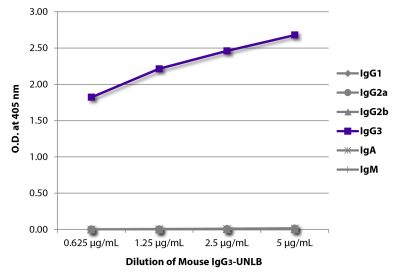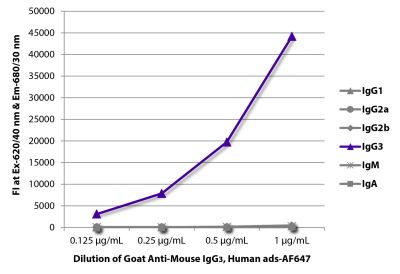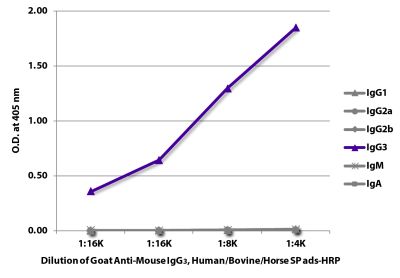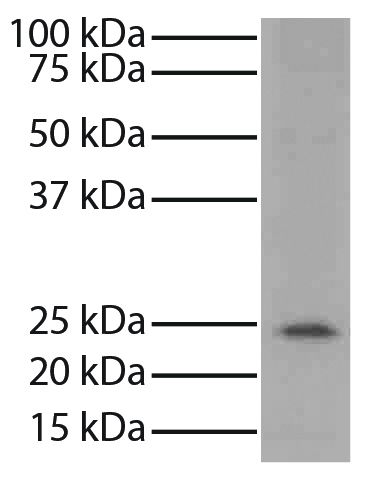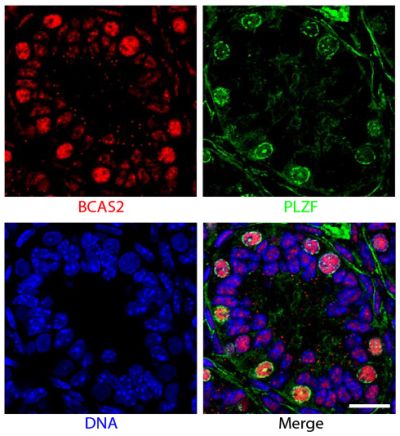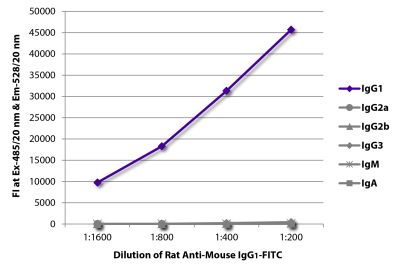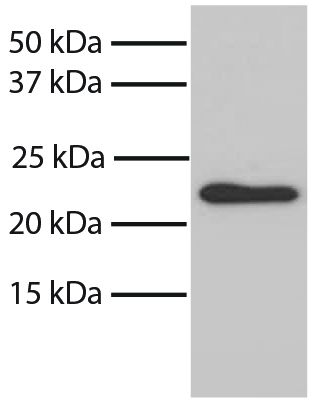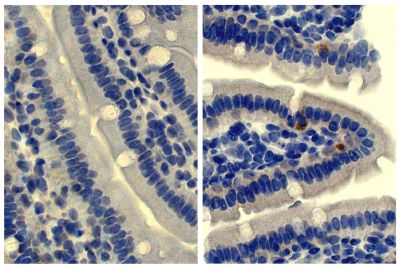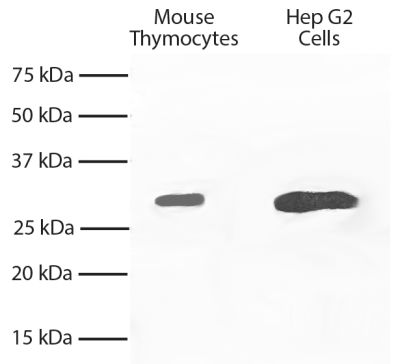Mouse Anti-Bcl-xL-UNLB (7B2.5)
Cat. No.:
10030-01
Purified Anti-Bcl-xL antibody for use in flow cytometry, immunohistochemistry / immunocytochemistry, ELISA, western blot, and immunoprecipitation assays.
$376.00
| Clone | 7B2.5 |
|---|---|
| Isotype | Mouse (BALB/c) IgG3κ |
| Isotype Control | Mouse IgG3-UNLB (B10) |
| Specificity | Human/Mouse/Rat/Rhesus Bcl-xL |
| Alternative Names | Apoptosis regulator Bcl-X, Bcl-2-like 1 protein, BCL2L1 |
| Description | Bcl-xL is a 29 kDa member of the Bcl-2 family of proteins involved in regulation of programmed cell death, or apoptosis. It is found in both soluble and membrane fractions of cellular lysates. Like Bcl-2, Bcl-xL has been demonstrated to block apoptosis which is induced by a variety of stimuli and, under certain conditions, offers greater protection against apoptosis than Bcl-2. While formation of heterodimers with the apoptosis-enhancing protein Bax does not block the apoptosis-suppressing property of Bcl-xL, heterodimerization with Bad effectively inhibits the protective function of Bcl-xL. |
| Immunogen | Recombinant human Bcl-xS |
| Conjugate | UNLB (Unconjugated) |
| Buffer Formulation | Borate buffered saline, pH 8.2 |
| Clonality | Monoclonal |
| Concentration | 0.1 mg/mL |
| Volume | 1.0 mL |
| Recommended Storage | 2-8°C |
| Applications |
Flow Cytometry – Quality tested 2-25 Immunohistochemistry-Paraffin Sections – Reported in literature 26 Immunocytochemistry – Reported in literature 27 Western Blot – Reported in literature 1,28-30 Immunoprecipitation – Reported in literature 30,31 ELISA – Reported in literature 1 |
| RRID Number | AB_2794101 |
| Gene ID |
598 (Human) 12048 (Mouse) 24888 (Rat) 713035 (Rhesus) |
| Gene ID Symbol |
BCL2L1 (Human) Bcl2l1 (Mouse) Bcl2l1 (Rat) BCL2L1 (Rhesus) |
| Gene ID Aliases | BCL-XL/S; BCL2L; BCLX; Bcl-X; PPP1R52; Bcl(X)L; Bcl-XL; Bcl2l; BclX; bcl-x; bcl2-L-1; Bcl-xl; Bclx; bcl-X; EGK_02534 |
| UniProt ID |
Q07817 (Human) Q64373 (Mouse) P53563 (Rat) |
| UniProt Name |
B2CL1_HUMAN (Human) B2CL1_MOUSE (Mouse) B2CL1_RAT (Rat) |
Documentation
Certificate of Analysis Lookup
Enter the Catalog Number and Lot Number for the Certificate of Analysis you wish to view
- 1. Boise LH, Minn AJ, Noel PJ, June CH, Accavitti MA, Lindsten T, et al. CD28 costimulation can promote T cell survival by enhancing the expression of Bcl-xL. Immunity. 1995;3:87-98. (Immunogen, WB, ELISA)
- 2. Hettmann T, DiDonato J, Karin M, Leiden JM. An essential role for nuclear factor κB in promoting double positive thymocyte apoptosis. J Exp Med. 1999;189:145-57. (FC)
- 3. Homann D, Teyton L, Oldstone MB. Differential regulation of antiviral T-cell immunity results in stable CD8+ but declining CD4+ T-cell memory. Nat Med. 2001;7:913-9. (FC)
- 4. Kreisel D, Krupnick AS, Balsara KR, Riha M, Gelman AE, Popma SH, et al. Mouse vascular endothelium activates CD8+ T lymphocytes in a B7-dependent fashion. J Immunol. 2002;169:6154-61. (FC)
- 5. Jahrsdörfer B, Jox R, Mühlenhoff L, Tschoep K, Krug A, Rothenfusser S, et al. Modulation of malignant B cell activation and apoptosis by bcl-2 antisense ODN and immunostimulatory CpG ODN. J Leukoc Biol. 2002;72:83-92. (FC)
- 6. Petrovas C, Mueller YM, Dimitriou ID, Bojczuk PM, Mounzer KC, Witek J, et al. HIV-specific CD8+ T cells exhibit markedly reduced levels of Bcl-2 and Bcl-xL. J Immunol. 2004;172:4444-53. (FC)
- 7. Wu LX, La Rose J, Chen L, Neale C, Mak T, Okkenhaug K, et al. CD28 regulates the translation of Bcl-xL via the phosphatidylinositol 3-kinase/mammalian target of rapamycin pathway. J Immunol. 2005;174:180-94. (FC)
- 8. Vigorito E, Gambardella L, Colucci F, McAdam S, Turner M. Vav proteins regulate peripheral B-cell survival. Blood. 2005;106:2391-8. (FC)
- 9. Homann D, Dummer W, Wolfe T, Rodrigo E, Theofilopoulos AN, Oldstone MB, et al. Lack of intrinsic CTLA-4 expression has minimal effect on regulation of antiviral T-cell immunity. J Virol. 2006;80:270-80. (FC)
- 10. Huddleston CA, Weinberg AD, Parker DC. OX40 (CD134) engagement drives differentiation of CD4+ T cells to effector cells. Eur J Immunol. 2006;36:1093-103. (FC)
- 11. Yadav A, Pati S, Nyugen A, Barabitskaja O, Mondal P, Anderson M, et al. HIV-1 transgenic rat CD4+ T cells develop decreased CD28 responsiveness and suboptimal Lck tyrosine dephosphorylation following activation. Virology. 2006;353:357-65. (FC)
- 12. Mueller YM, Petrovas C, Do DH, Altork SR, Fischer-Smith T, Rappaport J, et al. Early establishment and antigen dependence of simian immunodeficiency virus-specific CD8+ T-cell defects. J Virol. 2007;81:10861-8. (FC, Rhesus Reactivity)
- 13. Li S, Wang L, Zhao C, Li L, Peng J, Hou M. CD8+ T cells suppress autologous megakaryocyte apoptosis in idiopathic thrombocytopenic purpura. Br J Haematol. 2007;139:605-11. (FC)
- 14. Mueller KL, Thomas MS, Burbach BJ, Peterson EJ, Shimizu Y. Adhesion and degranulation-promoting adapter protein (ADAP) positively regulates T cell sensitivity to antigen and T cell survival. J Immunol. 2007;179:3559-69. (FC)
- 15. Hossain MZ, Yu Q, Xu M, Sen JM. ICAT expression disrupts β-catenin-TCF interactions and impairs survival of thymocytes and activated mature T cells. Int Immunol. 2008;20:925-35. (FC)
- 16. Barron L, Knoechel B, Lohr J, Abbas AK. Cutting edge: contributions of apoptosis and anergy to systemic T cell tolerance. J Immunol. 2008;180:2762-6. (FC)
- 17. Yang L, Wang L, Zhao C, Zhu X, Hou Y, Peng J, et al. Contributions of TRAIL-mediated megakaryocyte apoptosis to impaired megakaryocyte and platelet production in immune thrombocytopenia. Blood. 2010;116:4307-16. (FC)
- 18. Osborne LC, Duthie KA, Seo JH, Gascoyne RD, Abraham N. Selective ablation of the YxxM motif of IL-7Rα suppresses lymphomagenesis but maintains lymphocyte development. Oncogene. 2010;29:3854-64. (FC)
- 19. Chang C, Lai Y, Hou M, Huang P, Liao N. IL-15Rα of radiation-resistant cells is necessary and sufficient for thymic invariant NKT cell survival and functional maturation. J Immunol. 2011;187:1235-42. (FC)
- 20. Gross AJ, Proekt I, DeFranco AL. Elevated BCR signaling and decreased survival of Lyn-deficient transitional and follicular B cells. Eur J Immunol. 2011;41:3645-55. (FC)
- 21. Yao S, Zhu Y, Zhu G, Augustine M, Zheng L, Goode DJ, et al. B7-h2 is a costimulatory ligand for CD28 in human. Immunity. 2011;34:729-40. (FC)
- 22. Burns JC, Corbo E, Degen J, Gohil M, Anterasian C, Schraven B, et al. The SLP-76 Src homology 2 domain is required for T cell development and activation. J Immunol. 2011;187:4459-66. (FC)
- 23. Gordy LE, Bezbradica JS, Flyak AI, Spencer CT, Dunkle A, Sun J, et al. IL-15 regulates homeostasis and terminal maturation of NKT cells. J Immunol. 2011;187:6335-45. (FC)
- 24. Zhang T, Wu M, Sentman CL. An NKp30-based chimeric antigen receptor promotes T cell effector functions and antitumor efficacy in vivo. J Immuno. 2012;189:2290-9. (FC)
- 25. Min Y, Wang C, Li X, Hou Y, Qiu J, Ma J. Participation of BAFF receptors in the pathogenesis of immune thrombosytopenia(ITP). J Thromb Haemost. 2016 Jan 8. doi: 10.1111/jth.13246. [Epub ahead of print]. (FC)
- 26. Hartmann K, Artuc M, Baldus SE, Zirbes TK, Hermes B, Thiele J, et al. Expression of Bcl-2 and Bcl-xL in cutaneous and bone marrow lesions of mastocytosis. Am J Pathol. 2003;163:819-26. (IHC-PS)
- 27. Yamaguchi N, Kieba IR, Korostoff J, Howard PS, Shenker BJ, Lally ET. Maintenance of oxidative phosphorylation protects cells from Actinobacillus actinomycetemcomitans leukotoxin-induced apoptosis. Cell Microbiol. 2001;3:811-23. (ICC)
- 28. Kim H, Rafiuddin-Shah M, Tu H, Jeffers JR, Zambetti GP, Hsieh JJ, et al. Hierarchical regulation of mitochondrion-dependent apoptosis by BCL-2 subfamilies. Nat Cell Biol. 2006;8:1348-58. (WB)
- 29. Majors BS, Betenbaugh MJ, Pederson NE, Chiang GG. Enhancement of transient gene expression and culture viability using Chinese hamster ovary cells overexpressing Bcl-xL. Biotechnol Bioeng. 2008;101:567-78. (WB)
- 30. Broustas CG, Ross JS, Yang Q, Sheehan CE, Riggins R, Noone A, et al. The proapoptotic molecule BLID interacts with Bcl-XL and its downregulation in breast cancer correlates with poor disease-free and overall survival. Clin Cancer Res. 2010;16:2939-48. (WB, IP)
- 31. Passer BJ, Pellegrini L, Vito P, Ganjei JK, D'Adamio L. Interaction of Alzheimer's presenilin-1 and presenilin-2 with Bcl-XL. A potential role in modulating the threshold of cell death. J Biol Chem. 1999;274:24007-13. (IP)
See More


